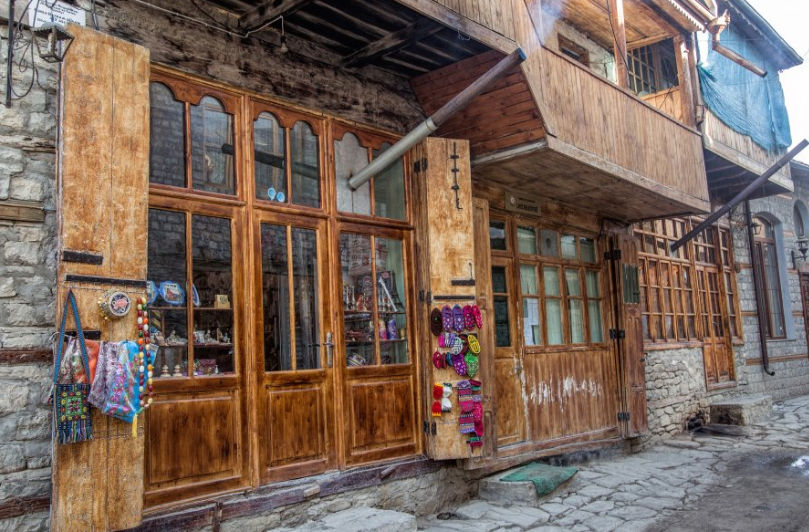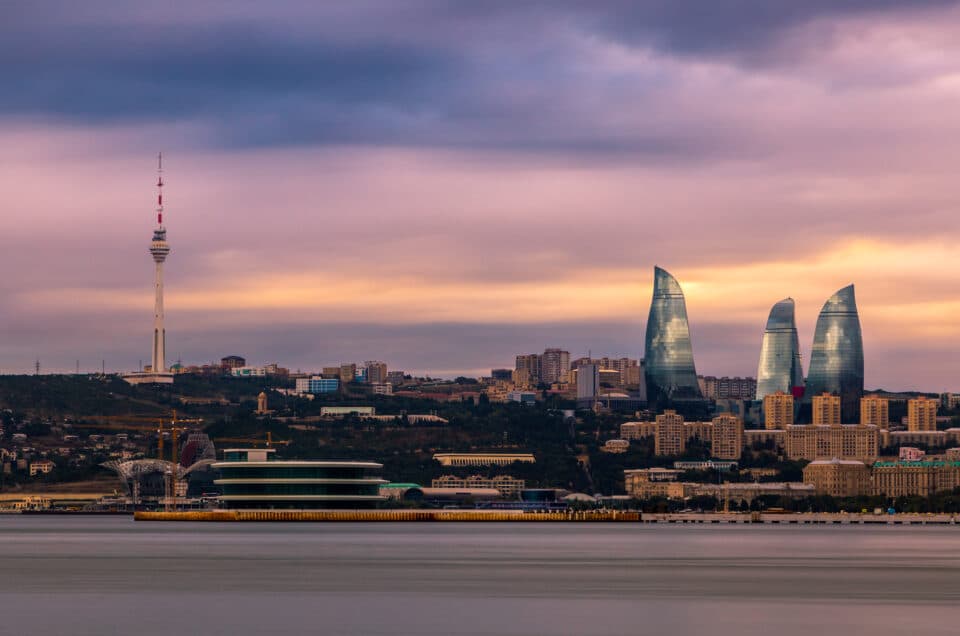One of the most popular routes in Azerbaijan is a tour to Lagich, the “City of Masters” in the Ismayilli region. Even if you do not set yourself the goal Lagich, only one road there is a landmark! The fact is that this is not a road, but a continuous extreme in half with incredible beauty. This 25 km can be traveled in 40 minutes, or 2 hours. And the last – more likely, because at every turn of the mountain serpentine I want to stop and take pictures.
Episodes of the movie “The Lord of the Rings” could be safely shot not using computer graphics but on the road to Lagich. This notorious computer graphics is babbling compared to the beauties of that road!
On one side, sheer cliffs, of an utterly Gothic form, stand up.
In the summer they are half hidden by foliage, so it is not visible that the rocks are multicolored. In winter, it is noticeably better and admires the inventions of Mother Nature.
This is one of the most beautiful mountain roads in Azerbaijan! Yes, probably in the world.
From time to time something falls from the rocks, it is a zone of permanent rockfalls, so part of the road is not asphalted – there is simply no point in this. If you look closely, then on the other side of the gorge, you can see a mountain path. Four goats famously jump on it.
Suddenly, close by – and this is about a kilometer and a half above the ground – we see people in the same quantity that go (or crawl?) Along this path.
Under the goats 15 meters, you can see a fragment of the cobblestone masonry, in some places lined with gorgeous greenish (visible even from a distance) tiles. Previously, the road was on the other side of the gorge; these are remnants of the 19th-century cladding.
It is said that, according to the decree of Tsar Nicholas II, they gave a gold chervonets per meter of this road – so he stimulated its construction. The way was built and functioned until the 60s. Twentieth-century. But it was hazardous, and from the Ismailis to Lahij could only be reached on foot or horseback.
Since the road was built in the middle of the XX century, and there was no way to Lahić through which transport could take place, isolation arose that allowed people to preserve the uniqueness and uniqueness of the local culture. Approximately the same as the originality of its culture, Japan has kept for centuries.
This isolation allowed to keep the language – an odd mixture of Farsi, Turkic, and Tat languages. On this cocktail, the Lagichs communicate with each other so far, and the inhabitants of the plain sometimes understand them with difficulty.
However, it is from here that one word has come which is understood literally by everything and everywhere. More precisely, not a word, but the name of an exciting backgammon game: “Shesh-besh.” The first half of the name of Persian origin is “six,” and the second Turkic is “five.”
And here we are in Lahij. Magical place!
On the bank of Girdymanchay, a river of stone, which in the spring turns into a real river, on a high slope there is a town under tiled roofs, built of river stone. The same stone-paved its streets.
The houses are built with seismicity: several layers of stone are necessarily shifted by thick wooden beams, which serve as a shock-absorbing pillow. In the same way, modern Lahij houses are being built, which are all stretched in three or four tiers along Girdymanchaya.
“Girdyman,” by the way, means “Country of big people.” Where does this name come from, nobody knows. There are a lot of strange and beautiful names in Lagich: Mosque Zevero, Badoi and Arakit, Il Bridge, and the very name of the city. It is not known what it means and where it came from.
Once upon a time, this area belonged to the Sassanian Empire. One of the Persian tribes called themselves “Lahij.” The empire sunk into oblivion, but the people remained, went to the mountains of the Greater Caucasus away from historical cataclysms. Among the incredibly beautiful mountain ranges, they built themselves a city.
Today, many mountain villages, unfortunately, are becoming empty. Therefore Lahij is declared a historical and cultural reserve. But this is not a frozen dead museum – life here still goes on as usual. However, the reserve regime is in effect: construction of bricks and other modern materials is prohibited – so that the appearance of Lahić is preserved in its original form. However, the regime will be violated. Directly opposite the remarkable Museum of History and Local Lore, located in the former mosque of Agola, built-in 1914.
There are almost no cars in Lahij, and there is no public transport at all. Many residents ride, as in the old days. And in the mountains for wood, and on the plain for groceries. Also, on horseback, for hundreds of years, the fame of local artisans from Lahij spread across all neighboring countries along with carpets, copper jugs and richly decorated weapons. There was even a profession – chalvadar. They were intermediary merchants who took out all kinds of local art from Lahij.
Copperware from Lagich adorns not only anywhere, but in the Louvre, but richly decorated with engraving, chasing and inlaying the products of gunsmiths (who were considered the best in the Caucasus and Transcaucasia and valued more than Kubachinsky ones) occupy a worthy place in the Berne Museum.
At the exhibition of works of the Transcaucasian Territory in 1850, products of Mamed Kadyr, presented to a cash award for copper dishes, were marked. Lagich masters demonstrated their products at the Vienna World Exhibition in 1873
Also famous and leather goods, goatskin, shagreen, yuft. Other handicrafts flourished based on a developed local leather industry, which has a handicraft character: saddlery, saddlery, shoe, hat, a furrier. Not having historical grounds for land, the locals have always been engaged in crafts, and the results of their labor were sold on the plains. With the money raised, the necessary products were purchased.
Generally, they say that before the crafts in Lahic were about 300. And various workshops – about 180. Indeed, from generation to generation, ancient skills and abilities are carefully transferred here. The son of the chaser became a chaser, the daughter of a weaver since childhood sat at the loom.
In the notorious times of collectivization, weavers were herded into workshops and obliged to over-fulfill the plan. Individuals were not encouraged, therefore, probably out of dozens of crafts, only a few survived. The carpet artel still works here – a dozen girls weave carpets. Girlish hands flicker so quickly that you can see how the pattern is born.
Leather and copper workshops are now far from 180. However, they are, and you can admire the exhibits of improvised museums that are arranged in each of them. There are old bowls, samovars, “lamps of Aladdin” and other simple utensils. On the wall of one of the workshops is the skeleton of a mummified cat. It is believed that she drives out evil spirits. Accurate, near – a portrait of Lenin. No other magic cat can banish this evil spirit.
Unfortunately, next to authentic workshops, there are numerous souvenir shops crammed with glittery Chinese knick-knacks that have the same attitude to Lagich products, a sombrero to Sweden. They look highly alien. Similarly, the new wooden lacquered doors, gates, and window frames look foreign. More and more appears in the Lagich remake.
But local women look very organic, looking for water with jugs of domestic production. By the way, antique dishes can be purchased relatively inexpensive. The basis of the ornament on it is a complex composition with straight and broken lines, with many points, triangles, rhombuses, etc. They were complemented by floral motifs, images of birds and animals, and later – the sun and people. On each product, the author wove a personal stamp, name, date, and place of manufacture into the ornament.
While we were walking along Lagich, through the open doors (the doors are not locked there in principle. There is no need – all of their own) saw patios and even some rooms.
It is not good to pry (especially since tourists, among residents, are already, perhaps, resentful: there are crowds here, even people come from Japan, and they all get bored – they try to look in, take a picture), but how else will you understand life?
And life is amazing! Cleanliness in homes and courtyards is sterile! The firewood in the woodpiles is stacked one to one, as in a shop window (there is no gas, it is heated by fireplaces, they cook food on stoves), and there are no motes on the concrete pavements. There are five shops in the whole city.
By the way, the Lahij people are offended if you call their town a village. This is a city, albeit a small one, only a couple of thousand inhabitants. It was the city because, firstly, since ancient times, Lagich was isolated and had to provide itself with all the necessary things. At the beginning of the XX century. Here lived almost 10 thousand inhabitants.
Now there are seven districts in Lahij. Almost every mosque, a small square, a hammam, a spring. And secondly, quite unexpectedly it turned out that the village becomes a city if it has a sewage system. And in Lahij sewage there. Yes, what!
From all houses, liquid waste is collected in large pipes laid under the streets, and go far, far away to the gorge. Where the sewer starts and where it ends – nobody knows. By what principle it works – nobody knows either. But this does not prevent her from functioning correctly for about three thousand years!
How can this be – a mystery that many scientists have sought to unravel.
Specialists from Germany tried to penetrate that mysterious pipe at the beginning of our century, but for some reason, they failed.
Revealed some area, climbed six meters, and stuck.
The only conclusion they made was the sewage system of Lahich based on the principle of sewage in ancient Rome. No wonder – these cities are almost the same age!
I would compare Lagich to another ancient city, French Carcassonne. With this fortress city located in Languedoc, Lahij is related to the fact that both of these cities are mothballed. Although in Carcassonne, a plastic fence will not meet for anything!
Getting to Lahij is simple: you can buy a ticket to Ismailov, and then take a taxi. Prices are negotiable. You can go on a Lahij tour , and you can get by car. Almost at the very beginning of the road to Lahij, you will meet a picturesque suspension bridge. Only with its help, you can get to the remote village Zernava. Back in May of this year, the bridge could be used without problems.
And just five days ago, I was surprised to see an evil, untidy man who demanded 50 copecks for the opportunity to have my photo taken on the bridge.





